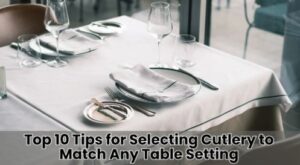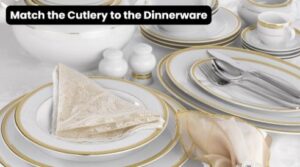Top 10 Tips for Selecting Cutlery to Match Any Table Setting

Have you ever faced a dilemma in selecting the appropriate cutlery for your dinner table, be it a holiday meal or simply to feed your family? With so many styles and materials presented for this need, choosing the right cutlery for a table setting can sometimes be fairly challenging. Utensils for dining add much to your table setting, making dining more enjoyable; they also make it beautiful.
The selection of cutlery, especially, determines the mood of the meal itself, whether elegant or simple, depending upon the occasion. For the ease and great benefit of making the right choices for any table setting, here are ten essential tips for helping you choose the best cutlery to complement your fine dining experience.
1. Understand the Occasion
The very first thing that has to be taken into consideration is the occasion that may just dictate what kind of cutlery to select. Whether it’s a family meal or the dinner party that everyone would have wanted, it goes with the characteristic of the kind of activity that you are engaged in. For example, a very important occasion such as a wedding reception or holiday dinner calls for classy cutlery.
Casual dinners might be met with a simple set of ready-to-use sturdy stainless steel or even bamboo cutlery. It might therefore be best for such meals to carry functional, and very easy-to-clean cutlery, perfect to complement a relaxed dinner party or Tuesday evening meal without overdoing it with the fancy look.
2. Match the Cutlery to the Dinnerware

The art of setting a table properly starts with establishing harmony through matching dinnerware and cutlery.
The pattern, color, and theme of your plates, bowls, and glassware can help guide the choice of cutlery to create a harmonious table setting. If you’re using sabre cutlery, you would want to select pieces in a similar style, such as those made from silver plate or sterling silver, to complement its elegant design. This attention to detail ensures a cohesive and refined dining experience.
3. Consider the Materials
Cutlery is made in all sorts of materials, which have their advantages and disadvantages. Of course, the most common is stainless steel due to its durability, affordability, and resistance to rusting or corroding. For a bit more high-class feel, sterling silver would be fantastic, but it does require more maintenance, like polishing regularly to keep the shine.
There is also ceramic or wooden cutlery, usually used in casual meals, outdoor or ambient dining materials often have the look of virgin beauty and may just be more environmentally friendly, just right for the environmentally conscious buyer.
4. Choose the Right Number of Pieces

Correct the number of items needed in your table setting through the use of a corresponding right utensil for each course. Although a full formal place setting would generally feature a salad fork, dinner fork, soup spoon, and dessert spoon, in addition to the basic dinner knife and fork, you would want to ensure that when you’re serving more than one course, there would at least be the correct utensil in order not to confuse your guest during consumption.
5. Consider Comfort and Weight
Though aesthetics are more than a consideration, comfort is also a priority in the selection of your cutlery. The weight of your utensils has to strike a great balance within the hand, neither heavy nor light in weight. A perfectly balanced piece of cutlery will become a far more comfortable dining experience because guests hosting you can now hold and use it with relative ease.
Additionally, pay close attention to the style and shape of the handles. A well-contoured handle will make a big difference in comfort, especially with longer meals or guests who may struggle with standard utensils.
6. Pay Attention to Design and Style
Cutlery is available in thousands of designs. They vary from sleek and modern to ornate and traditional cutlery designs. You may choose the kind of cutlery that better goes with the general theme or set-up of your table.
For example, should you want to achieve a modern, minimalist view, then select clean lines, and simple cutleries, and avoid highly decorated designs. However, for more traditional kinds of table setups, more ornate cutlery materials with many designs and patterns would be suitable to convey elegance and refinement.
7. Durability and Maintenance
Durability is an important quality when choosing cutlery. For everyday use, the most durable and maintenance-free option would be stainless steel. But if you settle for silver-plated or sterling silver cutlery, then get ready to shell out time on the care of that cutlery. Silverware has to be polished to keep its luster up, and eventually re-plated when it becomes too shabby.
For example, stainless steel cutlery is easily cleaned in the dishwasher and is rust and tarnish-free. Decide on materials that last long according to your lifestyle and the frequency of use.
8. Match Cutlery with Glassware and Serving Pieces
When you set your table, it’s very important that you consider not only how your cutlery matches your dinnerware but also your glassware and your serving pieces. So if you’re using fine crystal glasses, for example, you might want to use elegant silver or polished stainless cutlery; but if you’re using rather rustic wooden or ceramic-style bowls or plates, you might want a simpler, less showy array of utensils.
9. Choose Cutlery That Suits Your Hosting Style
Consider your hosting style and frequency of entertaining in choosing cutlery. If you host formal dinners or have large groups over frequently, a higher-end piece set with many more items will be worth it. However, if it is more of a simple meal with family or you’re entertaining less, you’ll probably want a smaller set of more basic pieces.
You may ask yourself how often you will use your cutlery and if you are going to use a lot for various occasions or special ones for certain events.
10. Set a Budget
| Aspect | Details |
| Price Consideration | Prices for cutlery vary widely. High-end sets, especially those made from sterling silver, can be expensive. These are ideal for special occasions. |
| Practical Options | For daily use, high-quality stainless steel cutlery offers great durability and a range of designs at more affordable prices. |
| Budget Planning | Setting a budget beforehand helps narrow down choices and ensures the cutlery selected is within your comfort level. |
| Investment Worth | While higher-end sets may be costly, they are a good investment for long-lasting quality, especially for formal or special events. |
| Quality vs. Price | You can find durable, stylish, and functional cutlery within a range of budgets, so balancing quality and price is important. |
Conclusion
Choosing the perfect table setting for your cutlery calls for more than picking the most aesthetically pleasing options. By reflecting on occasion, materials, design, comfort, and overall functionality, you may make a cutlery choice that creates an improvement in your meal and makes the right dinner ambiance.
Whether it is a formal dinner or a casual family meal, these ten tips help you to choose the right cutlery for any occasion to ensure your table setting is both practical and stylish.
FAQs
- What is the most important factor in choosing cutlery for a table setting?
The most important factor is matching the cutlery to the occasion, ensuring it complements the formality or casual nature of the event.
- How do I know which material is best for my cutlery?
Stainless steel is durable and easy to maintain, making it ideal for everyday use. Silver-plated or sterling silver is more elegant but requires more care.
- Do I need different cutlery for every course?
Yes, for formal occasions, different utensils may be needed for each course, such as a salad fork, soup spoon, and dessert spoon.
